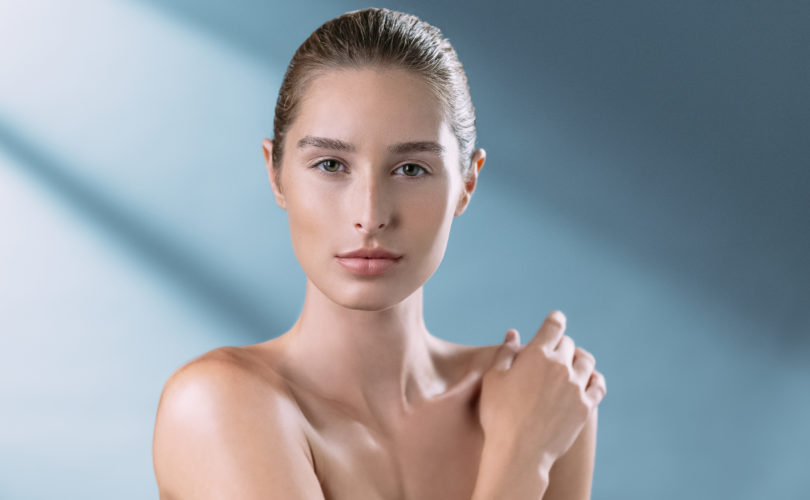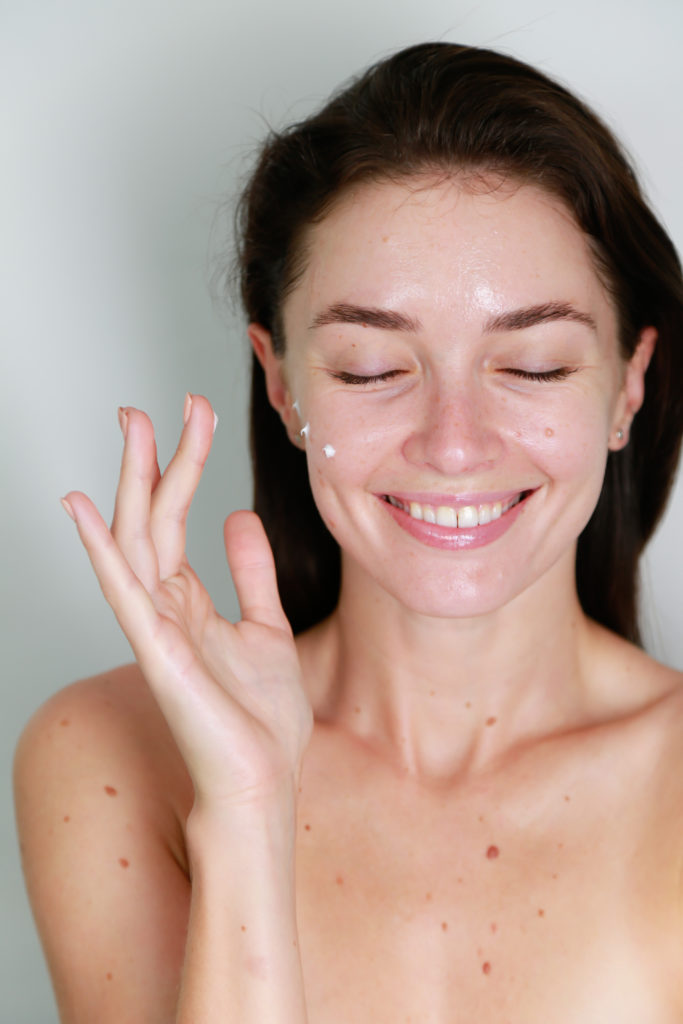Boosting esthetic skills by learning about the latest research in ingredients and treatment for dry skin is not only an important way to boost your business, but also serve clients in a much needed way. Here, I will provide insights into new research on the skin, as well as how products and ingredients can help alleviate dry and compromised skin concerns.
The latest research to consider what is on the new focus on the totality of the skin environment—what is termed, the matrisome—-much like the new focus in virtual space is the metaverse. The focus now is on the extracellular matrix, or ECM, which provides the skin with its major hydration properties. This complex network of proteins that comprise the ECM is lately been defined as the “matrisome”. Among these matrisome proteins, collagen is most abundant. Its specific amino acid sequence provides essential functions which can impact the aging process and influence the ECM and matrisome as a whole.
Forty years ago, to address these changes in the matrisome, we applied moisturizers made of oil, fragrance and water. The 21st century has ushered in a multitude of technological advances in skin care that include moisturizing bioadvanced ingredients such as sustainably-harvested seaweed extracts, peptides, niacinamide, and hyaluronic acid.
According to the latest data, 25.54 million Americans used a hydrating moisturizer, cream, or lotion for the face 14 times or more within a week. U.S. prestige skin care sales were up 18% in 2021, totaling $6.3 billion. On the mass beauty side, facial treatment sales jumped 54%, facial skin care sales rose 21%. According to NPD, 35% of female Gen Z skin care users say anti-aging ingredients are important.
Caring for the ECM
The newest product formulations not only help to hydrate the skin’s surface, but also address a wide array of skin concerns from oiliness to anti-aging.
The skin’s moisture barrier exists in the epidermal barrier primarily within the stratum corneum. This barrier has many important functions, including the maintenance of the permeability barrier, by monitoring water content, acting as an anti-microbial and immune response barrier to outside invaders such as microbial organisms, photo-protection barrier to help mediate the effects of ultraviolet (UV) light exposure and mitigation of the effects of oxidative stress by providing an antioxidant barrier. By maintaining proper water balance within the skin cells and mitigating environmental and microbial stresses, the stratum corneum sustains normal sloughing of skin cells as well as the skin’s elasticity.
One of the skin’s most important functions is to retain water without letting it escape into the environment. Skin itself is between 50% and 75% water, with the deeper tissues of the skin comprised of large cells loaded with dense levels of moisture. In fact, there is a moisture differential of 80% at the lower layers and 15% at the upper layers. With such a great difference, there will be a natural tendency for the moisture to move from the lower layers to the upper layers through osmosis to create a movement is called trans-epidermal moisture loss (TEWL).
As we know, when the stratum corneum is intact and healthy, it serves as an effective barrier to inhibit evaporation. If the cells are packed tightly together, TEWL cannot occur, but if the cells are loosely packed and flaking, the moisture can easily evaporate. Evaporation will occur anytime the surrounding environment drops to below 80% humidity.
The moisture barrier also relates to the skin’s Natural Moisturizing Factor (N.M.F.). This is comprised of fats, water, sugars, minerals and amino acids. The less N.M.F the person’s skin has, the more dehydrated the surface will appear. If the skin has a naturally adequate covering of sebum or moisturizer over its surface, the N.M.F. cannot evaporate to the same extent and the skin will remain hydrated. If you over-dry the surface and remove the natural covering, the N.M.F. evaporates. This gives the common result of a naturally oily skin with surface dehydration.
The ECM is comprised of an organized structure of glycosaminoglycans, proteoglycans, glycoproteins, growth factors, and structural proteins, such as collagen and elastin. Therefore the goal is to use hydrating products that help maintain the ECM, and therefore help maintain the integrity of the of matrisome’s collagen and elastin cache.
Hydrating products have three principal actions: emollient, humectant and occlusive.
The mechanism of emollients utilizes saturated and unsaturated hydrocarbons with variable length which improves skin barrier function, resulting in overall improvement of skin texture. Emollients are often combined with emulsifiers to help create a uniform texture. Common emollient ingredients used in formulations include fatty acids, fatty alcohols, cholesterol, squalane, and ceramides.
Humectants are low molecular substances in general, that work by attracting water to the stratum corneum. These are frequently used with other compounds which may retain the water content. Common humectants include urea, sorbitol, panthenol, glycerol, hyaluronic acid, and alpha hydroxy acids.
Occlusive ingredients form an inactive layer on the skin surface to physically block water evaporation from the skin (TEWL). Ingredients for this include silicones and zinc oxide
Hydrating Professional Treatments and Ingredients:
Skin hydration is significantly increased by a product formulated to mimic the skin’s own natural moisturizing systems. One of the most important hydrating ingredients for this is Seaweed. Laminaria Digitata and Ascophyllum Nodosum Seaweeds have been shown to have the greatest bio-affinity to the human body, its chemical makeup closest to the elements found in human plasma. These particular seaweeds are a source of many important nutrients, including polyunsaturated fatty acids, enzymes and bioactive peptides. Essential fatty acids help maintain our skin’s barrier, and polysaccharides such as Alginic Acid, help to lock moisture into our skin.
One of the most important skin concerns occur during oncology treatment. The skin barrier can become severely compromised and irritated, necessitating the use of a highly adapted protocol and treatment regimen. This protocol can be adapted for the many clients who come into the spa and salon starting in the fall through the winter to address dry, compromised skin through soothing, hydrating facial treatments.
Hydrating Serum, Creams, Essences and Masks
Skin care products differ in the amount of hydration they supply. Hydration is important for all skin types, including those prone to oiliness. When it comes to product type, the biggest difference between products is that some of them contain primarily hydrating ingredients (and active ingredients like antioxidants, peptides, acids and vitamins) on the one hand, and then moisturizing ingredients on the other. Moisturizing ingredients, unlike hydrating ingredients, adds oils and lipids. These types of ingredients tend to have an occluding effect, and hinder water evaporation from the skin, while also lubricating the skin.
“Lighter” products such as mists and serums predominately contain hydrating ingredients. Facial mists are generally purely hydrating. These products can be appropriate for all skin types, can contain specific treatment ingredients to address certain skin concern, and can be used alone through-out the day or under serums and moisturizers to increase hydrating benefits.
Serums are water-based skincare products that are usually meant to be used under a moisturizer. Different serums contain different ingredients aimed at targeting specific skin concerns, such as wrinkles, uneven skin tone and texture, and redness. Serums might have more moisture, but are still primarily hydrating and have more concentration of active ingredients. They are water based which makes them lightweight and quickly absorbed into the skin. Because serums tend to be light and water based, most skin types can use them.
Moisturizing lotions and creams vary widely in how much moisture they give, from caring for oily skin to heavily moisturizing dry skin.
Lotions have a high water content and are usually lighter-weight and non-greasy. These qualities make lotions a good choice for very oily skin types, as they are less likely to clog pores and leave a heavy residue on the skin than creams.
In general, creams have lower water content, so they are generally thicker and richer. Creams provide a physical barrier on your skin to help seal in moisture, making them ideal for dry skin types. These can also include additional ingredients to address signs of aging.
Gels generally contain even more water content than lotions and are usually oil-free, making them a good moisturizing choice for oily skin types. Balms are comprised of occlusive ingredients to help create a significant moisture barrier to the skin, and can be used on both the face and the body.
Masks are the most varied of all. They might be gel masks with little oils, or with a high amount of oils or butters, for dry skin.

Hydrating Ingredient Options:
In addition to seaweed, there are a variety of hydrating ingredients. Some work primarily by hydrating, while others also have additional effects on the skin.
- Niacinamide/Vitamin B3: This ingredient is known to have numerous proven skin benefits, including helping improve the overall appearance and texture of the skin, evening the appearance of skin complexion, reducing the appearance of fine lines and wrinkles as well as dark spots and discoloration, and improving the appearance of firmness and elasticity.
- Sodium Hyaluronate and Hydrolyzed Sodium Hyaluronate (Hyaluronic Acid): Hyaluronic Acid is a natural moisturizing polysaccharide prevalently found in the skin that is known to hold 1000X its weight in water. In the body, Hyaluronic Acid is known to help keep skin moisturized, repair skin tissue, transport nutrients in the blood to skin cells, serve as a cushion to lubricate and protect against damage, and contribute to the resilience and suppleness of the skin. As the body ages, Hyaluronic Acid decreases, leading to loss of moisture and elasticity, and contributing to the formation of lines and wrinkles. In skin care, benefits include intense hydration of the skin, helping skin to appear more plumped and diminishing the appearance of wrinkles. A major component of the ECM is hyaluronic acid (HA) which is produced mainly by fibroblasts and keratinocytes in the skin and may play an important role in epidermal barrier function and SC hydration. It is polysaccharides that are regarded as moisture-controlling substances, which is why they are included in hydrating formulas.
- Peptides: These are compounds of amino acids, the building blocks of proteins. Dipeptide-2, a string of 2 amino acids, helps to reduce the appearance of puffiness, and Palmitoyl Tripeptide-1 and Tetrapeptide-7 deeply moisturize the skin, helping to reduce the appearance of fine lines and wrinkles. Hexapeptide-2 is a fast-acting peptide that helps to brighten the appearance of the skin while Acetyl Hexapeptide-8 helps to reduce the appearance of wrinkles.
- Chios Mastiha (Mastic) Oil: From the island of Chios Greece, this extract is characterized by a balsam like odor and has been used in Greece for centuries. Chios mastic oil (CMO), the essential oil derived from Pistacia lentiscus has generated considerable interest because of its beneficial properties. In both essence and oil form, this ingredient is known to help strengthen the appearance of the skin barrier, to instantly help reduce dryness, while plumping the skin to provide lasting comfort.
- Camellia Japonica Seed Oil: One of the most important new ingredients that help strengthens skin barrier function and prevents moisture loss.
- Glycerin: This is a humectant that pulls water to the layers of the skin when applied. Glycerin has a low molecular weight. It is widely used in skin care products, but also in food and other areas as well. It is probably the most common hydrator. It would be useful for all skin types.
- Sodium PCA: The hydrating power of Sodium PCA is stronger than glycerin, and is also found in the body as a natural moisturizing factor. It holds its own weight in water many times. Concentrations vary, but can often be 2-7%.
- Lactic Acid: This is a member of the Alpha-Hydroxy Acid (AHA) family, and thus provides chemical exfoliation of skin cells. But it also has a moisturizing effect when applied to the skin, and is better tolerated than glycolic acid. It therefore has an anti-aging effect by reducing the appearance of fine lines and age spots. The downside of this ingredient is that it should not be used in higher concentrations, as it could irritate the skin. Typical concentrations are around 10% or lower. The molecular weight is relatively low.
- Squalane: A plant-derived hydrator, Squalane is also found in the skin. It resists oxidation and reduces moisture loss. It also improves the elasticity of and structure of the lipid film in the epidermis, and penetrates very well without feeling heavy on the skin. It would thus be suitable for oily skin as well as dry skin.
Taking the opportunity to provide yourself with affordable advanced esthetics education on the latest treatments and science for addressing dry skin concerns, will prepare you to meet and exceed your clients’ needs as we enter the winter months. This strategy of anticipating and exceeding their needs in skin care is the surest recipe for great success.

